Exhibit 99.1

ReZolve2 Implant and Pilot Trial Update at TCT 2013
San Diego, California and Sydney, Australia (Wednesday 30 October 2013, AEDT) — REVA Medical, Inc. (ASX: RVA) (“REVA” or the “Company”) announces that in conjunction with Transcatheter Cardiovascular Therapeutics 2013 (“TCT”), which is being held this week in San Francisco, a patient implant with the ReZolve®2 bioresorbable scaffold was transmitted live via satellite from the Institute Dante Pazzanese of Cardiology, in Sao Paulo, Brazil to an audience in the Main Arena. The implant was performed by Dr. Alexandre Abizaid, Director of Invasive Cardiology, and study co-investigator, Dr. J. Ribamar Costa.
The scaffold was implanted in a patient that presented with a blockage of the left anterior descending artery of the heart. The lesion was approximately 80% blocked and had evidence of moderate calcium. The procedure was performed using a 6 French radial approach, in which the scaffold is delivered to the heart through the radial artery of the wrist.
Commenting on the case, Dr. Abizaid stated, “We achieved a very successful acute result from this implant. The scaffold was easily delivered, and the procedure was aided by the complete visibility of the scaffold under x-ray and the ability to achieve the desired implant diameter with a single inflation.”
“This case marks the 87th patient enrolled in our ReZolve2 clinical trial,” commented REVA’s CEO, Bob Stockman. “The follow-up data from this case, along with data from up to 125 patients enrolled in the trial, will be used to apply for European CE Mark of the product toward the end of 2014.”
Additionally, Dr. Ricardo Costa, also from the Institute Dante Pazzanese of Cardiology, presented 12-month data at TCT on patients who were enrolled in the RESTORE pilot clinical trial between December 2011 and July 2012. The RESTORE pilot clinical trial was designed to evaluate the safety and performance of the first generation ReZolve® sirolimus-eluting bioresorbable coronary scaffold. Twelve-month angiographic follow-up was conducted to evaluate the change in the lumen area between the time of treatment when blood flow was restored and the time of follow-up, referred to as late lumen loss (“late loss”). Permanent drug-eluting stents have historically exhibited late loss values of 0.20 mm to 0.40 mm, which have generally corresponded to positive long-term outcomes.
In the patients treated with ReZolve who remained event free after treatment, imaging results demonstrated a mean in-stent late loss of 0.29 mm, which is well within the range of safety and performance of drug-eluting metal stents and bioresorbable scaffolds that are used today. When imaging results for patients who had undergone retreatment for focal in-stent restenosis, or renarrowing of the artery at the implant site are taken into consideration, the mean in-stent late loss is 0.69 mm.
HEAD OFFICE: 5751 Copley Drive, San Diego, CA 92111 · +1 (858) 966-3000 · +1 (858) 966-3099 (FAX) · www.revamedical.com |
AUSTRALIAN OFFICE: Level 6, 175 Macquarie Street, Sydney, NSW 2000 · +61 2 9231 3322 · +61 9229 2727 (FAX) · ARBN 146 505 777 |
REVA Medical, Inc., is a foreign company incorporated in Delaware, USA, whose stockholders have limited liability. |
| |
REVA Medical, Inc. — ASX Announcement | Page 2 |
| |
Commenting on the results, Dr. Costa stated, “The positive late loss results seen in the majority of patients demonstrates the platform’s ability to successfully treat coronary artery disease, before resorbing from the body, and returning the patient’s artery to its natural function. To reduce the incidence of retreatment, REVA developed ReZolve2, which is a lower profile scaffold with an approximate 30% increase in radial strength when compared to the original ReZolve device. Our center is now enrolling patients in a larger clinical trial with ReZolve2, and positive 30-day data was presented on the first 65 patients at TCT earlier this week.”
“The data from the patients treated with our first generation scaffold has been instrumental in advancing our product platform,” commented REVA’s CEO, Bob Stockman. “The current performance of ReZolve2, along with the additional advantages that will be realized by REVA’s pipeline bioresorbable scaffolds that are now in development, position REVA very strongly for the future.”
The presentation materials delivered by Dr. Costa at the conference are attached hereto. These materials are also being filed with the U.S. Securities and Exchange Commission and are posted under the Investor Relations section of REVA’s website at www.revamedical.com
About REVA
REVA is a development stage medical device company incorporated in Delaware, USA, that is focused on the development and eventual commercialization of its proprietary bioresorbable stent products. The ReZolve® product family, which is in a clinical study phase, combines REVA’s proprietary stent design with a proprietary polymer that is metabolized and cleared from the body. REVA’s anticipated initial commercial product, the ReZolve2 scaffold, is designed to offer full x-ray visibility, clinically relevant sizing, and a controlled and safe resorption rate. In addition, by early encapsulation of the stent in the artery tissue coupled with the loss of scaffold structure over time, the ReZolve2 scaffold may reduce the incidence of late forming blood clots or otherwise reduce long-term disease progression, potential benefits of bioresorbable scaffolds that have yet to be proven. REVA will require clinical results and regulatory approval before it can begin selling the ReZolve2 scaffold.
HEAD OFFICE: 5751 Copley Drive, San Diego, CA 92111 · +1 (858) 966-3000 · +1 (858) 966-3099 (FAX) · www.revamedical.com |
AUSTRALIAN OFFICE: Level 6, 175 Macquarie Street, Sydney, NSW 2000 · +61 2 9231 3322 · +61 9229 2727 (FAX) · ARBN 146 505 777 |
REVA Medical, Inc., is a foreign company incorporated in Delaware, USA, whose stockholders have limited liability. |
| |
REVA Medical, Inc. — ASX Announcement | Page 3 |
| |
Forward-Looking Statements
This announcement contains or may contain forward-looking statements that are based on management’s beliefs, assumptions and expectations and on information currently available to management. All statements that are not statements of historical fact, including those statements that address future operating performance and events or developments that we expect or anticipate will occur in the future, are forward-looking statements, such as those statements regarding our ability to obtain the regulatory approvals required to market our ReZolveÒ scaffold, our ability to timely and successfully complete our clinical trials, our ability to protect our intellectual property position, our ability to commercialize our products if and when approved, our ability to develop and commercialize new products, and our estimates regarding our capital requirements and financial performance, including profitability. You should not place undue reliance on these forward-looking statements. Although management believes these forward-looking statements are reasonable as and when made, forward-looking statements are subject to a number of risks and uncertainties that may cause our actual results to vary materially from those expressed in the forward-looking statements, which risks and uncertainties are described in the “Risk Factors” section of our Annual Report on Form 10-K filed with the United States Securities and Exchange Commission (the “SEC”) on 28 February 2013. Any forward-looking statements in this announcement speak only as of the date when made. REVA does not assume any obligation to publicly update or revise any forward-looking statements, whether as a result of new information, future events, or otherwise.
United States | Australia |
| |
Investor and Media Enquiries: | Investor Enquiries: |
Cheryl Liberatore | Kim Jacobs |
Director, Investor Relations and Marketing | Inteq Limited |
REVA Medical, Inc. | +61 2 9229 2700 |
+1 858 966-3045 | |
| Media Enquiries: |
| Haley Price or Rebecca Wilson |
| Buchan Consulting |
| +61 3 9866 4722 |
HEAD OFFICE: 5751 Copley Drive, San Diego, CA 92111 · +1 (858) 966-3000 · +1 (858) 966-3099 (FAX) · www.revamedical.com |
AUSTRALIAN OFFICE: Level 6, 175 Macquarie Street, Sydney, NSW 2000 · +61 2 9231 3322 · +61 9229 2727 (FAX) · ARBN 146 505 777 |
REVA Medical, Inc., is a foreign company incorporated in Delaware, USA, whose stockholders have limited liability. |
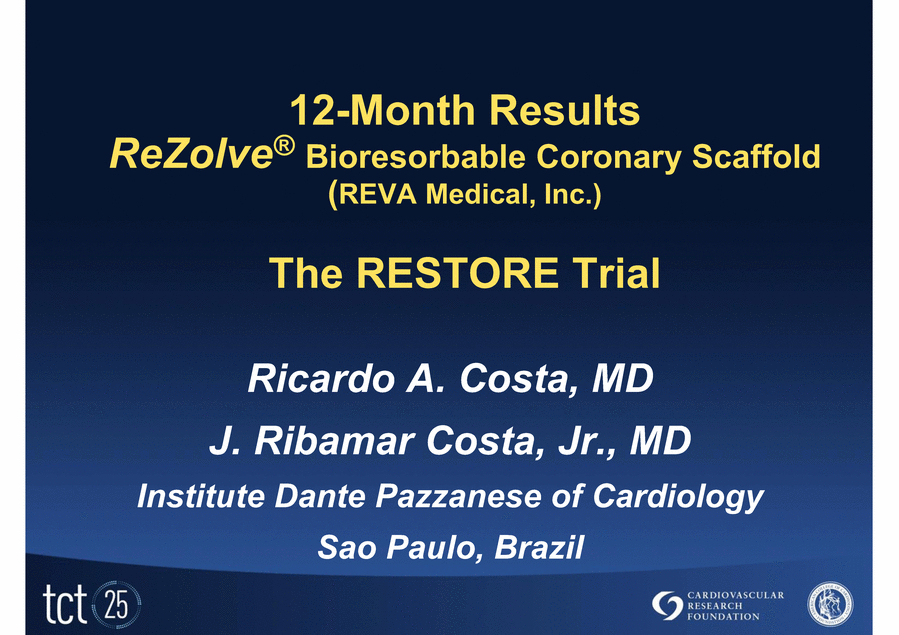
| 12-Month Results ReZolve® Bioresorbable Coronary Scaffold (REVA Medical, Inc.) The RESTORE Trial Ricardo A. Costa, MD J. Ribamar Costa, Jr., MD Institute Dante Pazzanese of Cardiology Sao Paulo, Brazil |
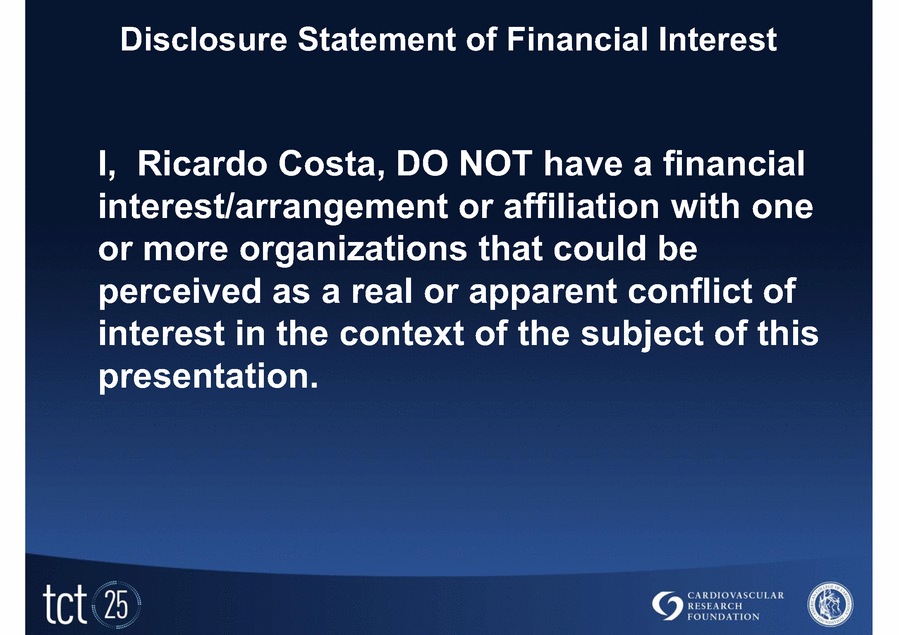
| Disclosure Statement of Financial Interest I, Ricardo Costa, DO NOT have a financial interest/arrangement or affiliation with one or more organizations that could be perceived as a real or apparent conflict of interest in the context of the subject of this presentation. |
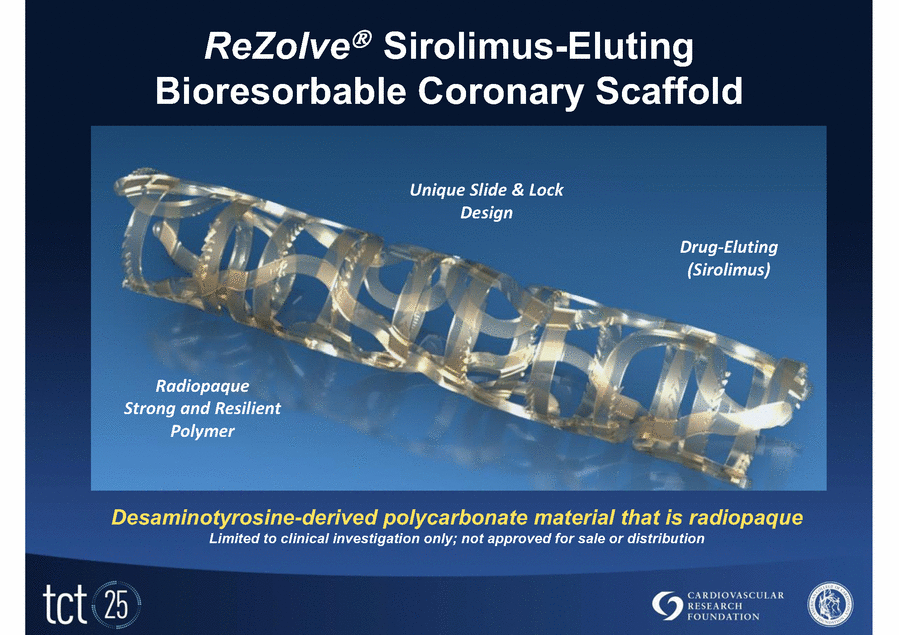
| ReZolve® Sirolimus-Eluting Bioresorbable Coronary Scaffold Drug-Eluting (Sirolimus) Radiopaque Strong and Resilient Polymer Unique Slide & Lock Design Desaminotyrosine-derived polycarbonate material that is radiopaque Limited to clinical investigation only; not approved for sale or distribution |

| ReZolve Proprietary Technology Ratchet design Strong Minimal recoil Desaminotyrosine Polycarbonate polymer Tunable Visible Biocompatible Doubles as a drug carrier Ratchet Concept Metal ReZolve ‘Slide & Lock’ design |
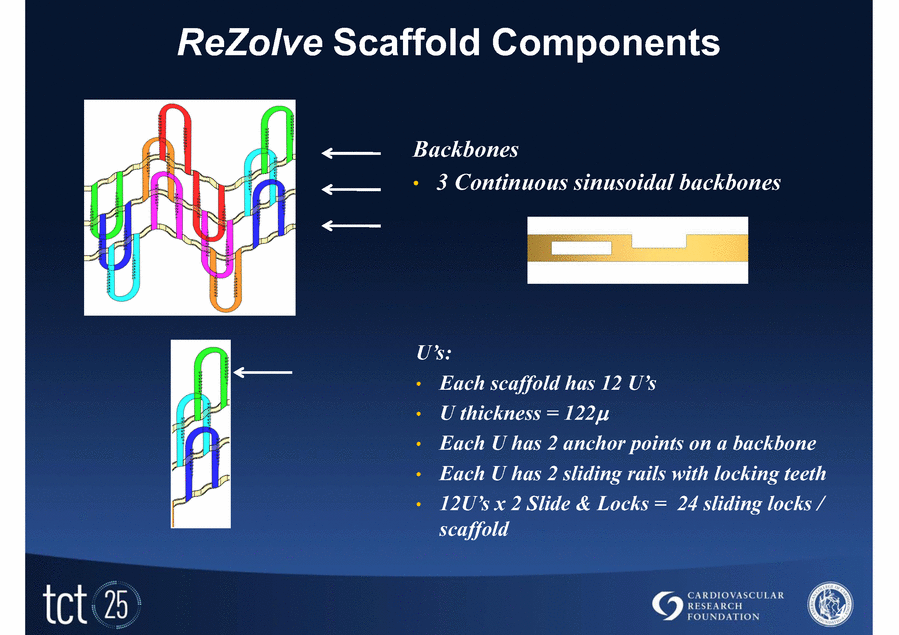
| ReZolve Scaffold Components Backbones 3 Continuous sinusoidal backbones Each scaffold has 12 U’s thickness = 122 Each U has 2 anchor points on a backbone Each U has 2 sliding rails with locking teeth 122µ Slide & Locks = 24 sliding locks / scaffold U’s |
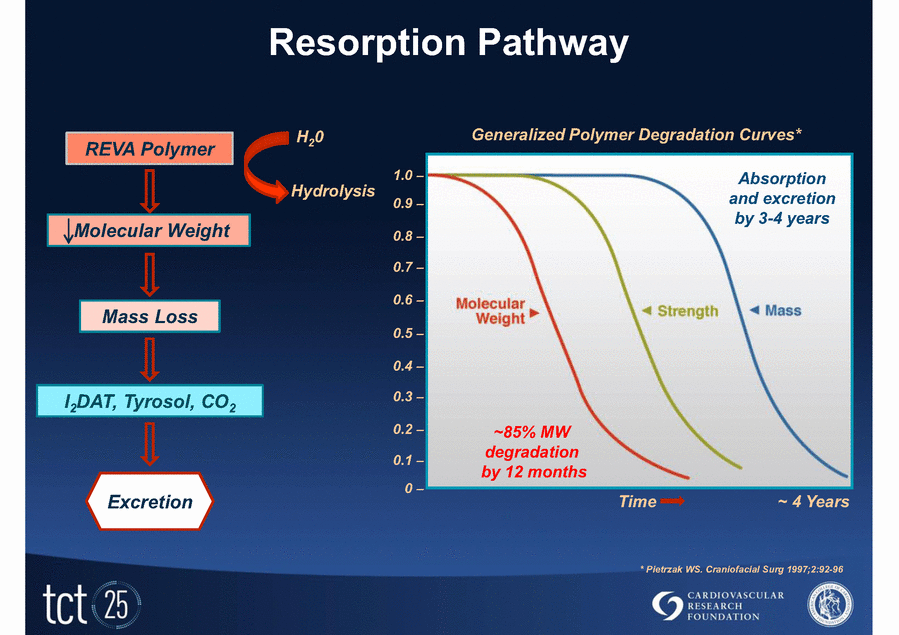
| Resorption Pathway * Pietrzak WS. Craniofacial Surg 1997;2:92-96 1.0 0.9 0.4 0.8 0.3 0.7 0.2 0.6 0.1 0.5 0 Time ~ 4 Years Generalized Polymer Degradation Curves* Hydrolysis REVA Polymer Molecular Weight Mass Loss I2DAT, Tyrosol, CO2 Excretion H20 ~85% MW degradation by 12 months Absorption and excretion by 3-4 years |
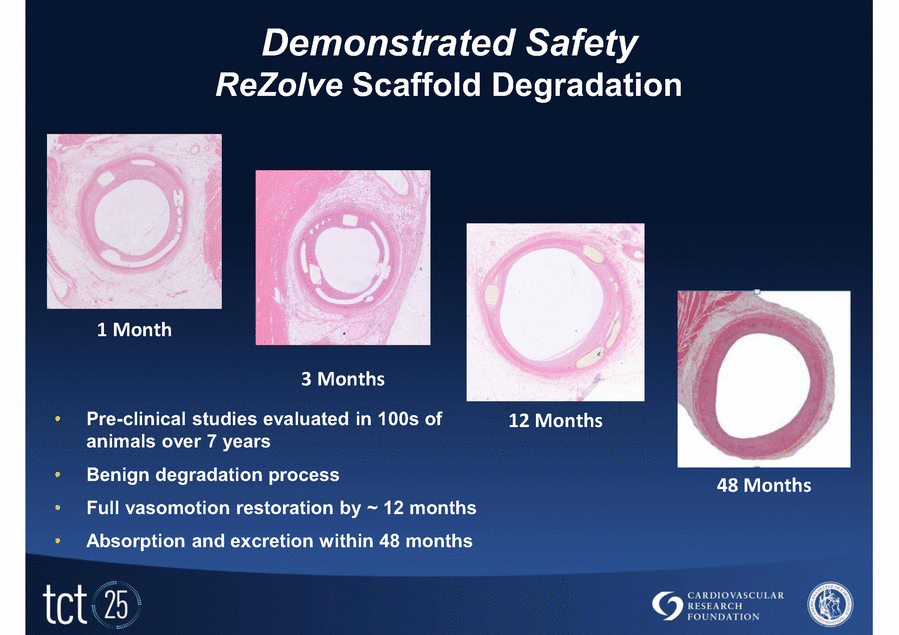
| Demonstrated Safety ReZolve Scaffold Degradation 1 Month 12 Months 3 Months 48 Months Pre-clinical studies evaluated in 100s of animals over 7 years Benign degradation process Full vasomotion restoration by ~ 12 months Absorption and excretion within 48 months |
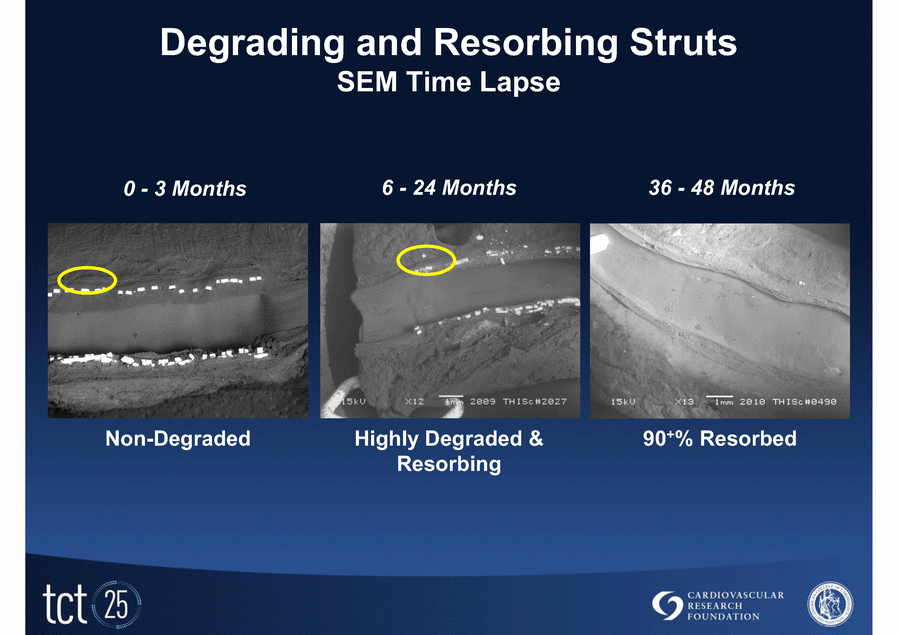
| Degrading and Resorbing Struts SEM Time Lapse Non-Degraded 90+% Resorbed Highly Degraded & Resorbing 0 - 3 Months 6 - 24 Months 36 - 48 Months |

| Release Kinetics of Sirolimus 0% 10% 20% 30% 40% 50% 60% 70% 80% 90% 100% 0 20 40 60 80 100 Percent Sirolimus Released Time (Days) ReZolve Cypher Xience Elution profile comparable to commercially successful products 80ug of Sirolimus abluminally coated on 3.0 x 18mm scaffold |

| ReZolve (gen. 1) RESTORE Pilot Clinical Trial ReZolve Sirolimus-Eluting Bioresorbable Coronary Scaffold Initiated December 2011 Enrolled 26 Patients Primary Endpoint(s): Freedom from ischemic-driven target lesion revascularization at 6 months Quantitative measurements at 12 months (QCA/IVUS) |
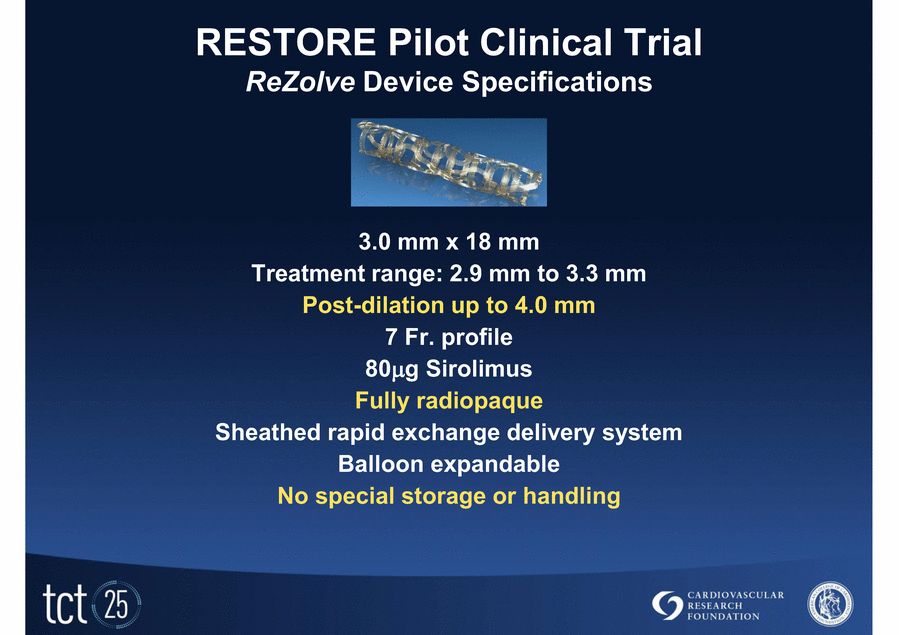
| RESTORE Pilot Clinical Trial ReZolve Device Specifications 3.0 mm x 18 mm Treatment range: 2.9 mm to 3.3 mm Post-dilation up to 4.0 mm 7 Fr. profile 80µg Sirolimus Fully radiopaque Sheathed rapid exchange delivery system Balloon expandable No special storage or handling |
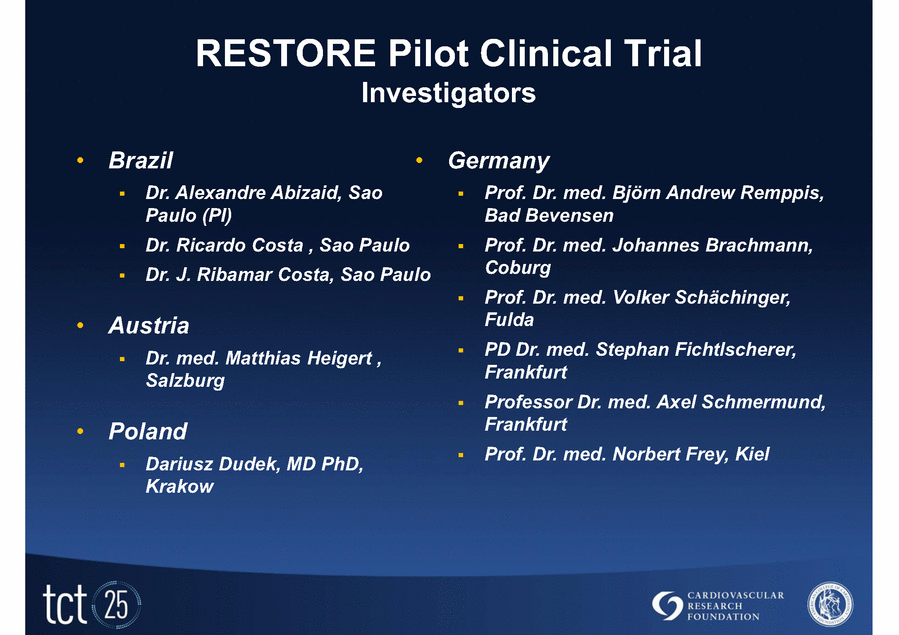
| RESTORE Pilot Clinical Trial Investigators Germany Prof. Dr. med. Björn Andrew Remppis, Bad Bevensen Prof. Dr. med. Johannes Brachmann, Coburg Prof. Dr. med. Volker Schächinger, Fulda PD Dr. med. Stephan Fichtlscherer, Frankfurt Professor Dr. med. Axel Schmermund, Frankfurt Prof. Dr. med. Norbert Frey, Kiel Brazil Dr. Alexandre Abizaid, Sao Paulo (PI) Dr. Ricardo Costa , Sao Paulo Dr. J. Ribamar Costa, Sao Paulo Austria Dr. med. Matthias Heigert , Salzburg Poland Dariusz Dudek, MD PhD, Krakow |
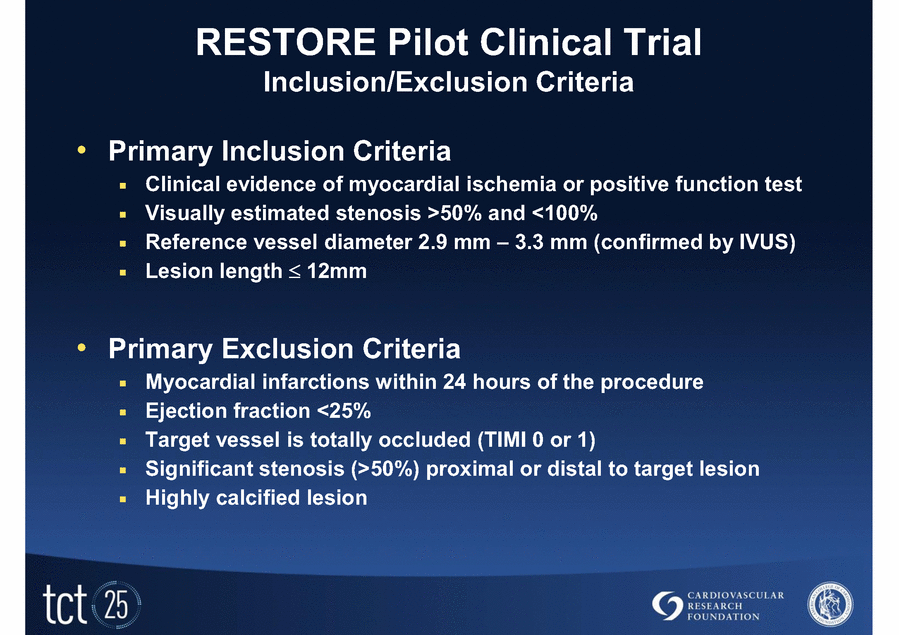
| RESTORE Pilot Clinical Trial Inclusion/Exclusion Criteria Primary Inclusion Criteria Clinical evidence of myocardial ischemia or positive function test Visually estimated stenosis >50% and <100% Reference vessel diameter 2.9 – mm 3.3 mm (confirmed by IVUS) Lesion length < 12mm Primary Exclusion Criteria Myocardial infarctions within 24 hours of the procedure Ejection fraction <25% Target vessel is totally occluded (TIMI 0 or 1) Significant stenosis (>50%) proximal or distal to target lesion Highly calcified lesion |
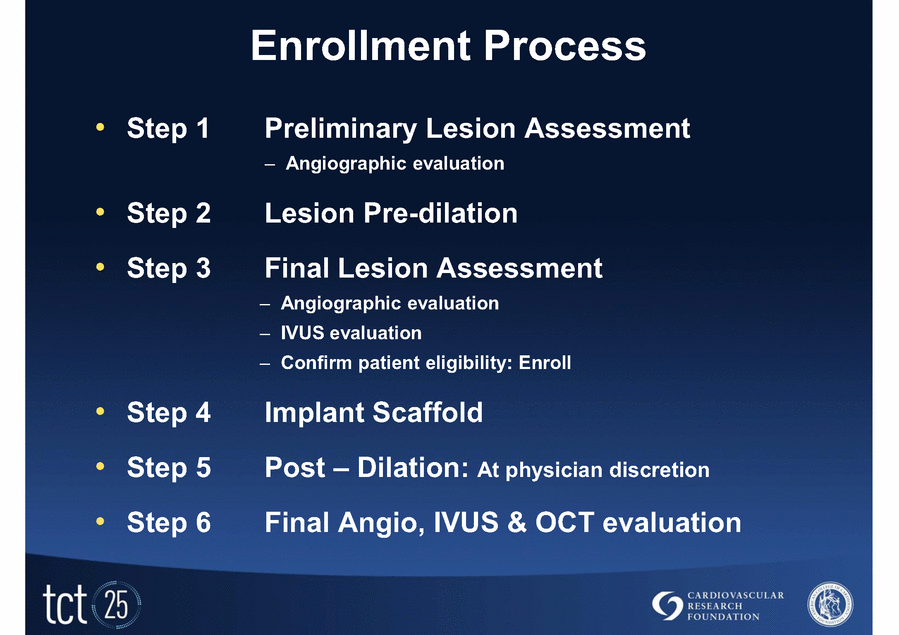
| Enrollment Process Step 1 Preliminary Lesion Assessment Angiographic evaluation Step 2 Lesion Pre-dilation Step 3 Final Lesion Assessment Angiographic evaluation IVUS evaluation Confirm patient eligibility: Enroll Step 4 Implant Scaffold Step 5 Post – Dilation: At physician discretion Step 6 Final Angio, IVUS & OCT evaluation |
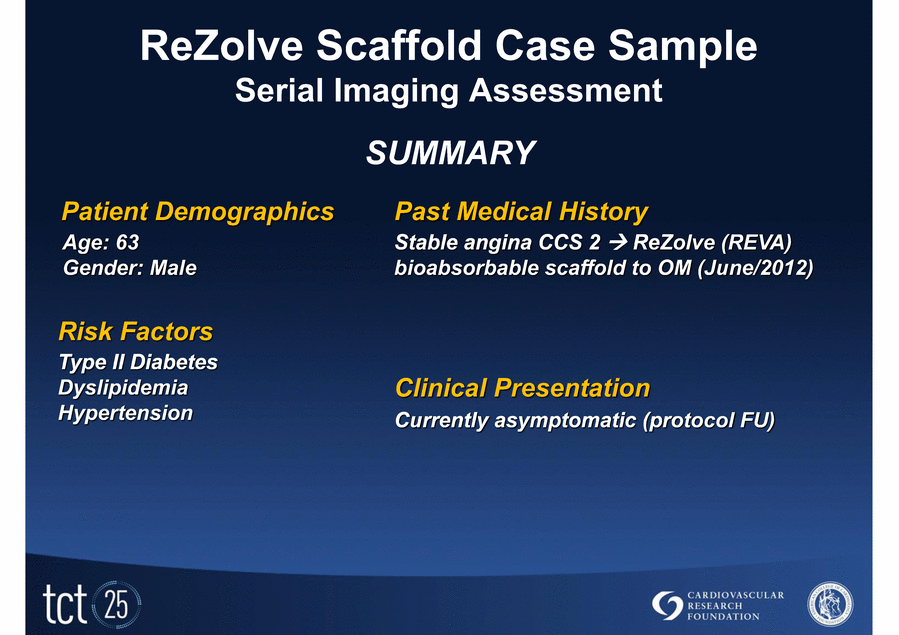
| ReZolve Scaffold Case Sample Serial Imaging Assessment SUMMARY Currently asymptomatic (protocol FU) Clinical Presentation Patient Demographics Age: 63 Gender: Male Type II Diabetes Dyslipidemia Hypertension Risk Factors Stable angina CCS 2 ReZolve (REVA) bioabsorbable scaffold to OM (June/2012) Past Medical History |

| BASELINE ANGIOGRAPHY SCAFFOLD DEPLOYMENT (3.0 x 18mm) POST DILATATION (3.5 x15mm) Instituto Dante Pazzanese de Cardiologia São Paulo, Brazil ReZolve Scaffold Case Sample |
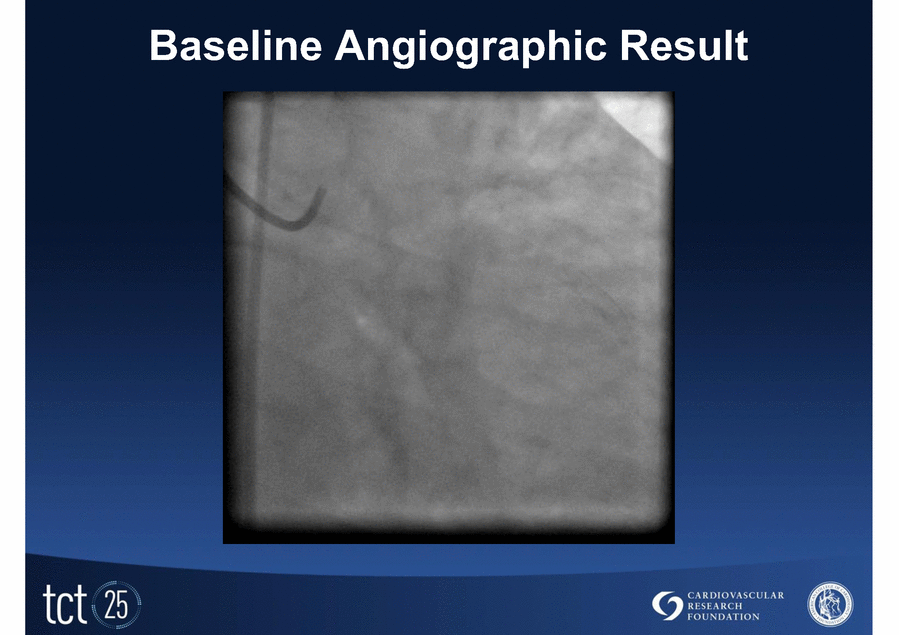
| Baseline Angiographic Result |
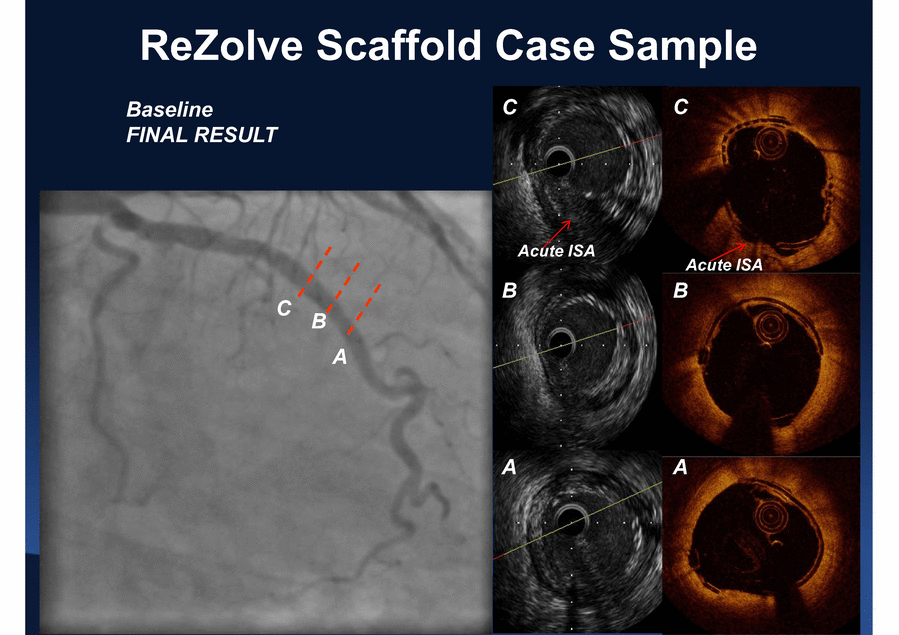
| Baseline FINAL RESULT Acute ISA A B C A B C A B C Acute ISA ReZolve Scaffold Case Sample |
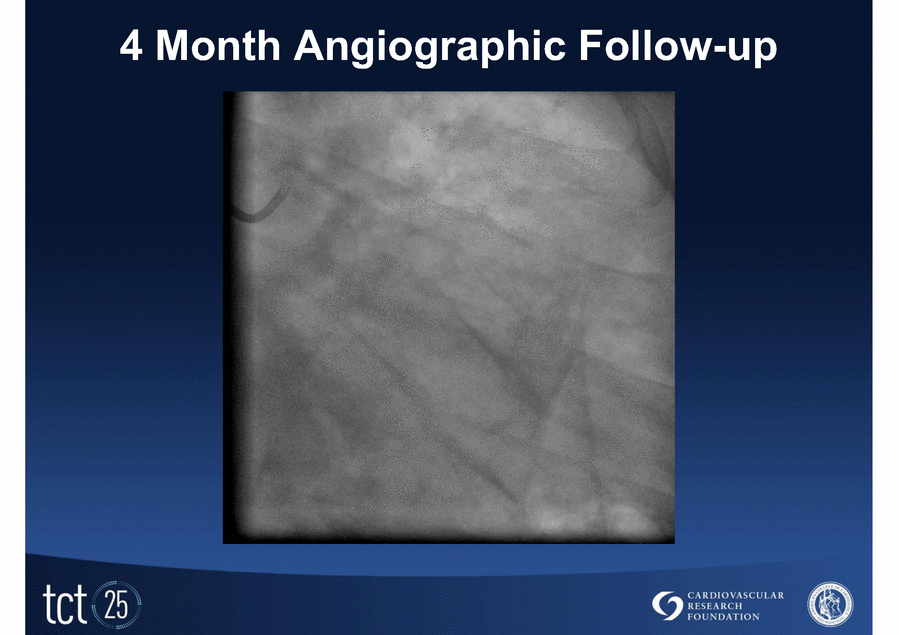
| 4 Month Angiographic Follow-up |
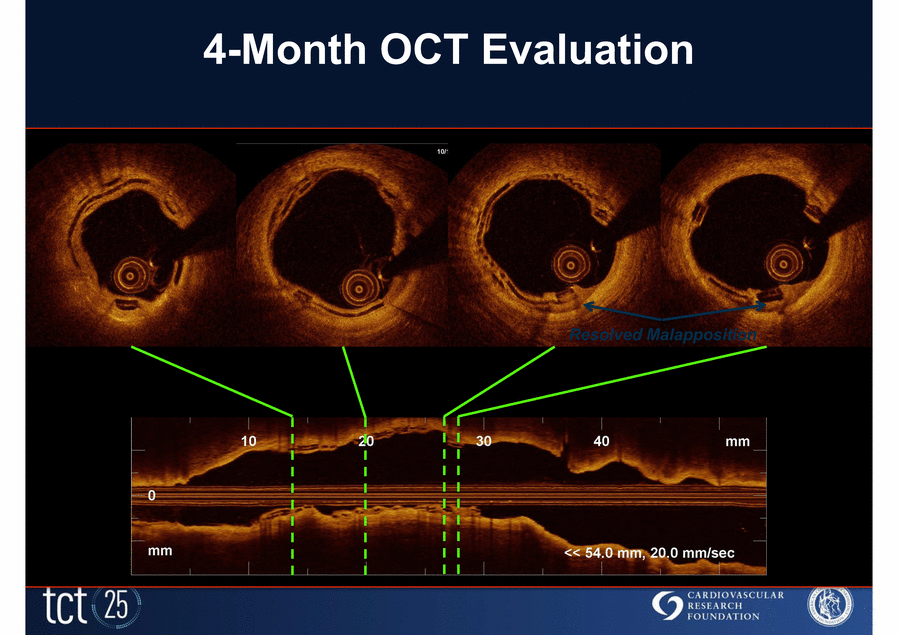
| 4-Month OCT Evaluation Resolved Malapposition |
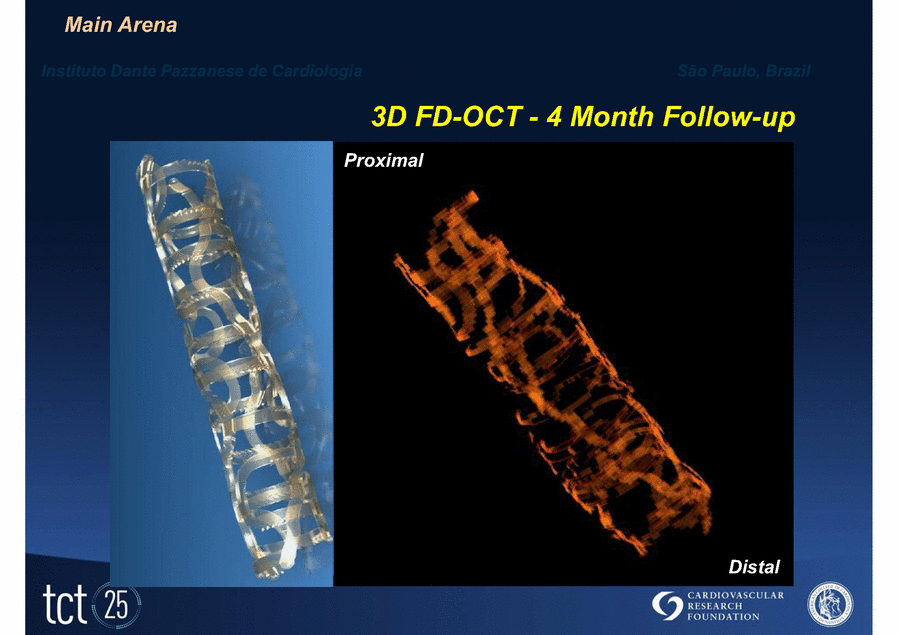
| Main Arena São Paulo, Brazil Instituto Dante Pazzanese de Cardiologia 3D FD-OCT - 4 Month Follow-up Proximal Distal |
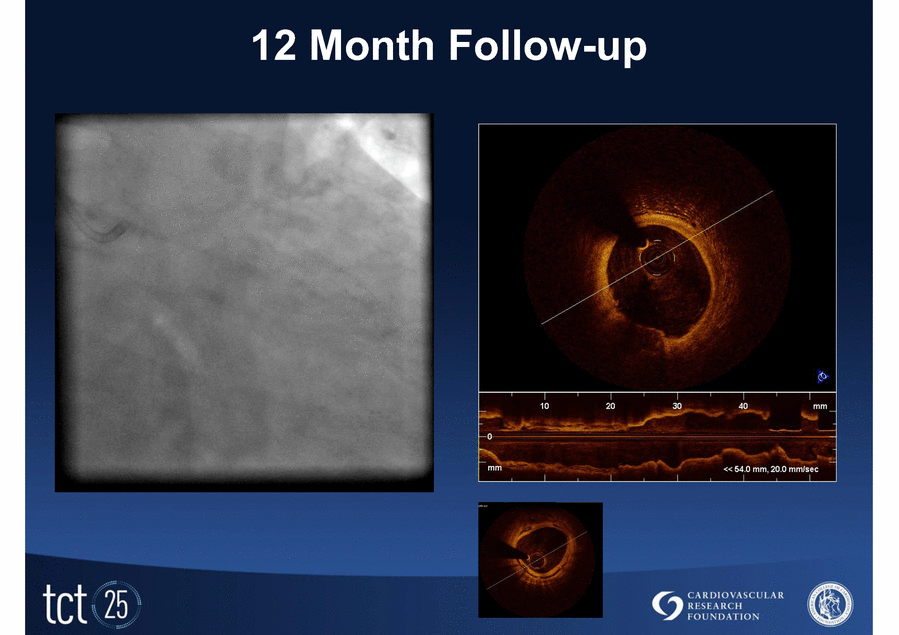
| 12 Month Follow-up |

| RESTORE Pilot Clinical Trial Preliminary Baseline Characteristics Patient Age (average years) 61 Male 76.0% Diabetes 36.0% Current/Former Smoker 48.0% Hypertension (requiring medication) 79.2% Hyperlipidemia (requiring medication) 79.2% Prior PCI 40.0% Prior CABG 0% Prior MI 36.0% LVEF 59.0% |
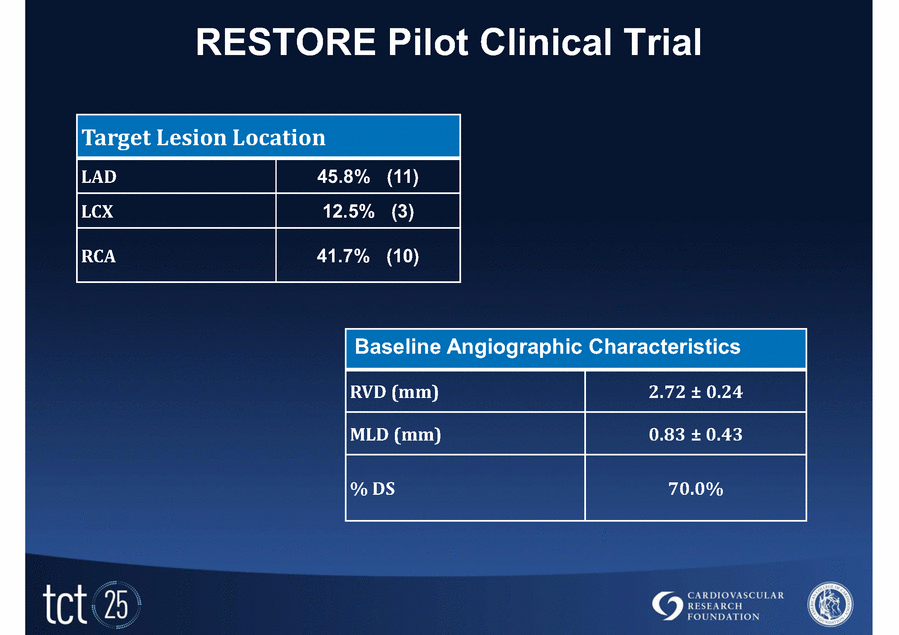
| RESTORE Pilot Clinical Trial Baseline Angiographic Characteristics RVD (mm) 2.72 ± 0.24 MLD (mm) 0.83 ± 0.43 % DS 70.0% Target Lesion Location LAD 45.8% (11) LCX 12.5% (3) RCA 41.7% (10) |
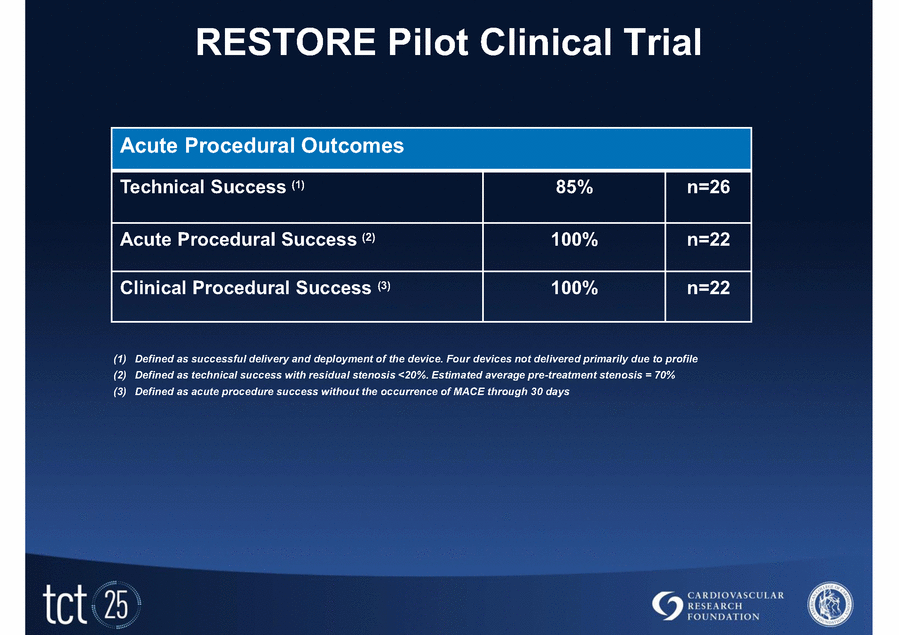
| RESTORE Pilot Clinical Trial Acute Procedural Outcomes Technical Success (1) 85% n=26 Acute Procedural Success (2) 100% n=22 Clinical Procedural Success (3) 100% n=22 (1) Defined as successful delivery and deployment of the device. Four devices not delivered primarily due to profile (2) Defined as technical success with residual stenosis <20%. Estimated average pre-treatment stenosis = 70% (3) Defined as acute procedure success without the occurrence of MACE through 30 days |
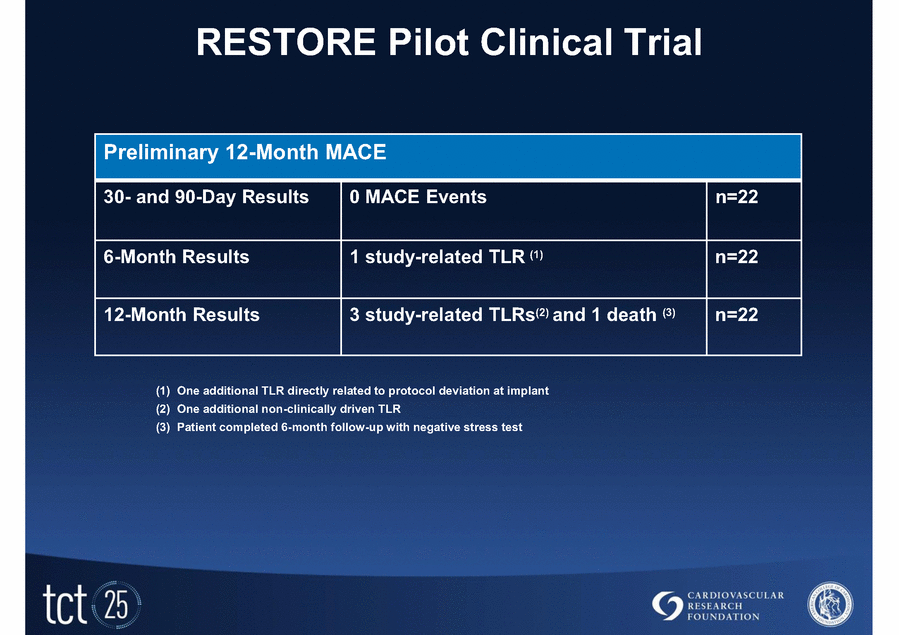
| RESTORE Pilot Clinical Trial (1) One additional TLR directly related to protocol deviation at implant (2) One additional non-clinically driven TLR (3) Patient completed 6-month follow-up with negative stress test Preliminary 12-Month MACE 30- and 90-Day Results 0 MACE Events n=22 6-Month Results 1 study-related TLR (1) n=22 12-Month Results 3 study-related TLRs(2) and 1 death (3) n=22 |
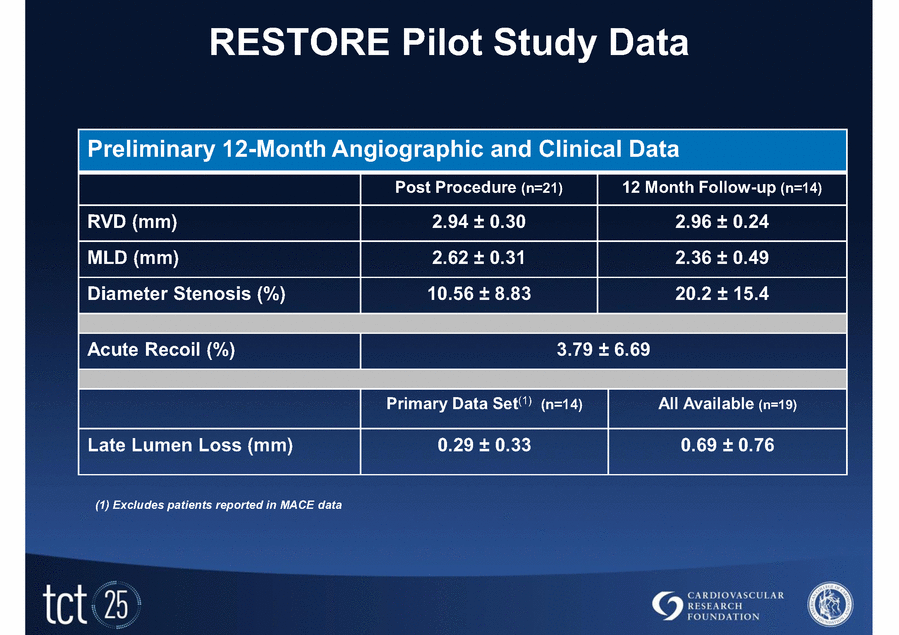
| RESTORE Pilot Study Data Preliminary 12-Month Angiographic and Clinical Data Post Procedure (n=21) 12 Month Follow-up (n=14) RVD (mm) 2.94 ± 0.30 2.96 ± 0.24 MLD (mm) 2.62 ± 0.31 2.36 ± 0.49 Diameter Stenosis (%) 10.56 ± 8.83 20.2 ± 15.4 Acute Recoil (%) 3.79 ± 6.69 Primary Data Set(1) (n=14) All Available (n=19) Late Lumen Loss (mm) 0.29 ± 0.33 0.69 ± 0.76 (1) Excludes patients reported in MACE data |
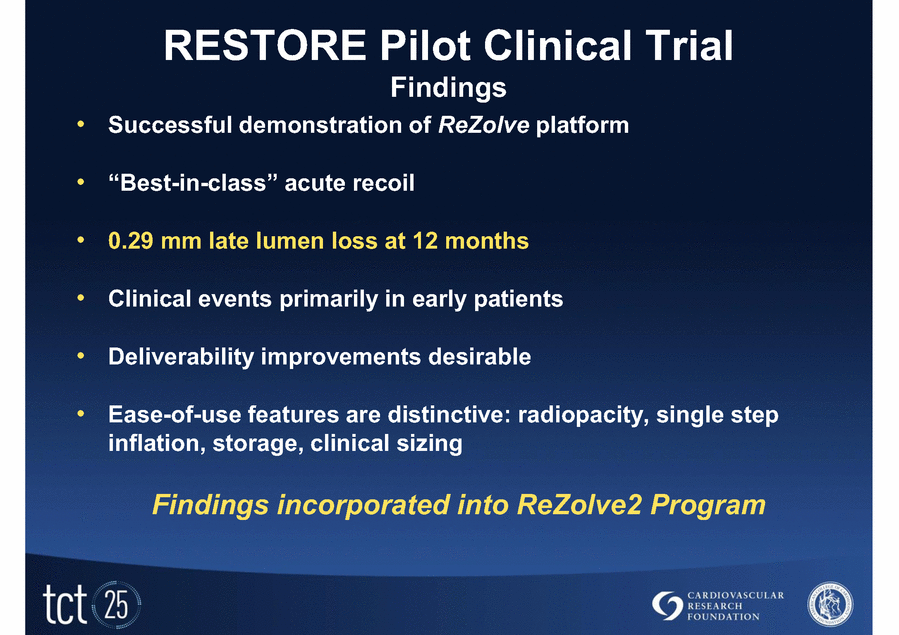
| RESTORE Pilot Clinical Trial Findings Successful demonstration of ReZolve platform “Best-in-class” acute recoil 0.29 mm late lumen loss at 12 months Clinical events primarily in early patients Deliverability improvements desirable Ease-of-use features are distinctive: radiopacity, single step inflation, storage, clinical sizing Findings incorporated into ReZolve2 Program |
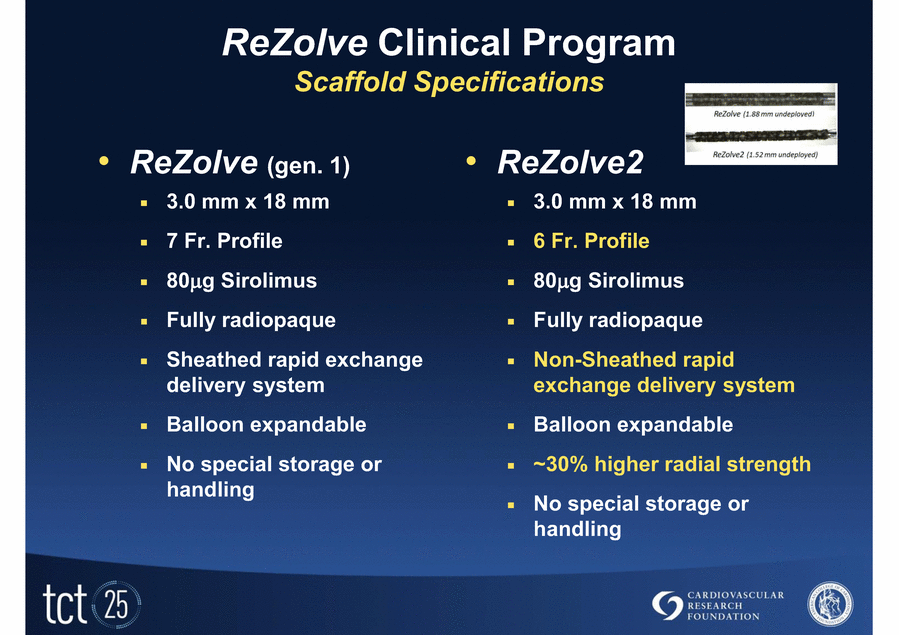
| ReZolve Clinical Program Scaffold Specifications ReZolve (gen. 1) 3.0 mm x 18 mm 7 Fr. Profile 80µg Sirolimus Fully radiopaque Sheathed rapid exchange delivery system Balloon expandable No special storage or handling ReZolve2 3.0 mm x 18 mm 6 Fr. Profile 80µg Sirolimus Fully radiopaque Non-Sheathed rapid exchange delivery system Balloon expandable ~30% higher radial strength No special storage or handling |
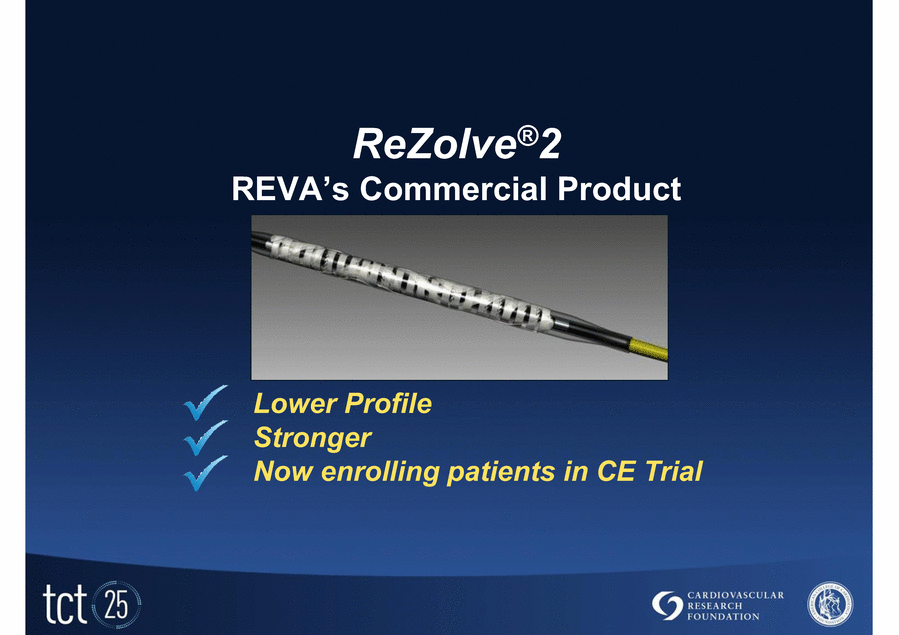
| ReZolve®2 Lower Profile Stronger Now enrolling patients in CE Trial REVA’s Commercial Product |
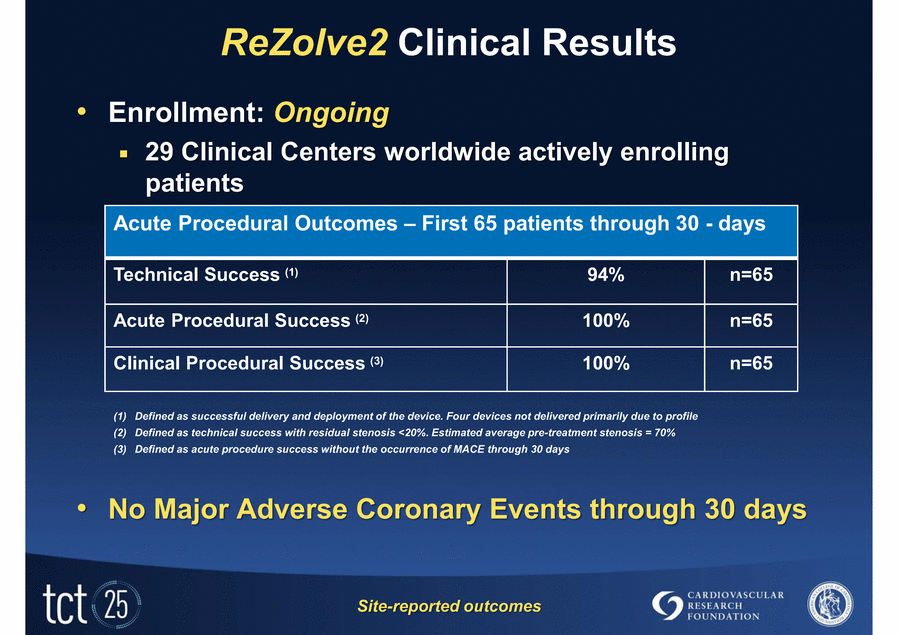
| ReZolve2 Clinical Results Enrollment: Ongoing 29 Clinical Centers worldwide actively enrolling patients No Major Adverse Coronary Events through 30 days Site-reported outcomes Acute Procedural Outcomes First 65 patients through 30 - days Technical Success (1) 94% n=65 Acute Procedural Success (2) 100% n=65 Clinical Procedural Success (3) 100% n=65 (1) Defined as successful delivery and deployment of the device. Four devices not delivered primarily due to profile (2) Defined as technical success with residual stenosis <20%. Estimated average pre-treatment stenosis = 70% (3) Defined as acute procedure success without the occurrence of MACE through 30 days |

| Thank you |
































